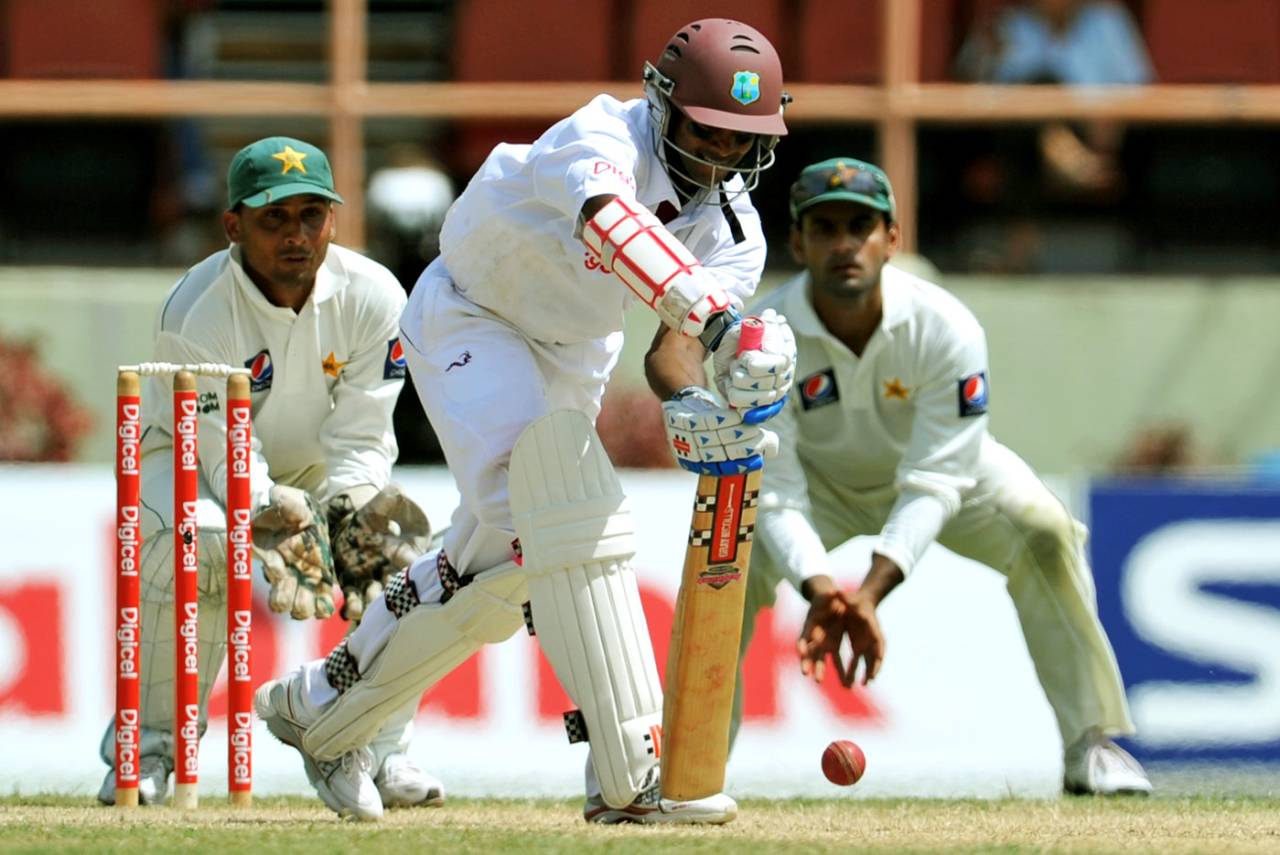So the King of Red Ink has laid down his crown. As
Shivnarine Chanderpaul takes his leave, it's appropriate that the record as cricket's
most not-out player goes with him, because throughout an era of mighty deeds with the willow, no one has been
as attached to the crease - Shiv's was a love that would not waver.
Imagine, then, that you were one of India's bowlers
in 2002, when you toiled for more than 25 hours and over a thousand deliveries without dismissing him. Or the bowlers of
Bangladesh and
England, who strained for more than 17 hours in 2004, or the Englishmen
of 2007, who were repelled for 17 hours in Manchester and Durham, or the Australians who encountered him in North Sound and Bridgetown for 18-plus hours
in 2008.
Put yourself in the shoes of the Bangladesh bowlers who met him when he was 40, batting undefeated through not just a match, but an
entire series. Or imagine you were a bowler turning up for your game for the Transport Social Club in Guyana, and discovering that he was batting No. 3 for the Ghandi Youth Organisation side, with his son Tagenarine at No. 4, and sweating through the 30-odd overs in which they piled up 256 together - unbeaten, of course. Or that you were Brett Lee, felling him with a
terrifying bouncer in Jamaica, only to find him still there, rock-like, an hour later, going past three figures. Or the Australian bowlers
in Georgetown on April 10, 2003, who had West Indies five down for 53 and were flayed for a 69-ball hundred...
His technique was forged on the hard floor of a community centre in Unity Village, where the ball would bounce, and out on the beach where it would skim, and where his dad, Khemraj, encouraged the bowlers to try and hit his son, a tiny, thin child, as watchful as a fly and just as elusive
Perhaps, then, when you went to sleep at night, imprinted on your eyelids was a vision of the square-on, sandshoe shuffle that seemed to start somewhere west of leg stump, the Gray-Nicolls bat wobbling out towards gully in its pick-up, hopes raised again and again by this mad, unorthodox position, only to see that hope continually snuffed out, that bat coming down again and again like an arrow, guided by a still head and a sure eye and the supplest of wrists, defending, dabbing, guiding, pushing, steering, driving.
The great golf coach John Jacobs once said that he could learn everything he needed to know about a player's swing by watching where the ball went. Contained within the moment of impact between club and ball was all of the information he required about the position of the club face. Draw, fade, high, low, fat, thin, pure… the rest was just noise. And so it was with Shivnarine Chanderpaul's much-discussed technique, forged, it's said, when he was eight years old, on the hard floor of a community centre in Unity Village, where the ball would bounce, and out on the beach where it would skim, and where his dad, Khemraj, encouraged the bowlers to try and hit his son, a tiny, thin child, as watchful as a fly and just as elusive. The bat was the thing, and the bat was in the right place, ball after ball, innings after innings, game after game, for decades to come, even as the movements around it grew more exaggerated with time.
What Shivnarine Chanderpaul did, between the ages of 19 and 40, which was score more runs for the West Indies Test team
than anyone except Lara, and how he did it, which was in his own inimitable way, somehow conspired to deny him the fuss and the fanfare that attended Lara, Sangakkara, Dravid, Kallis, Ponting and Tendulkar - the only men in history to have scored
more Test runs than him. For better or worse, aesthetics play into our judgement.
Shiv, who
played in more losing Test matches than anyone else, for a team that essentially fell apart during his watch, seemed like a throwback even as he batted, the last man standing from a disappeared age. He may well be the final West Indian to make 10,000 Test runs - it's hard to imagine anyone else playing enough matches, given the rate West Indies now play them. And who will have an appetite like his, a man still kicking and screaming for a game at the age of 41, a batsman so dedicated that he hired his own net bowlers, a player who so loves cricket he'll play in a club game on a Saturday off.
And yet Test cricket, that great anachronism, has such depth and scope, who knows. As time rushes away from Chanderpaul's era, the South African selectors picked a 33-year-old old-school opener with more than 30 first-class hundreds under his belt and discovered that he was actually quite good at it. England have opted for Nick Compton at three and have their own remorseless left-hander at the top of the order. Australia have picked Adam Voges and Pakistan won't let Misbah retire.
Chanderpaul's parting lesson might be that cricket is big enough to contain everything and everyone, and its quirks sometimes offer up some of the finest gold - and red.

